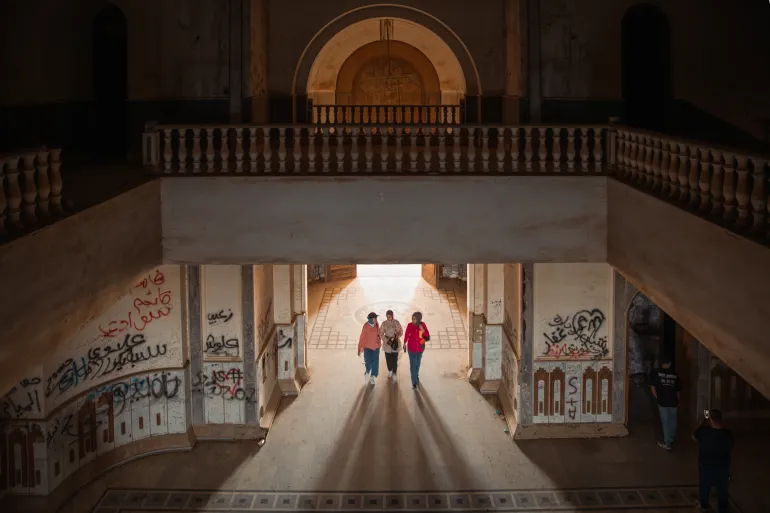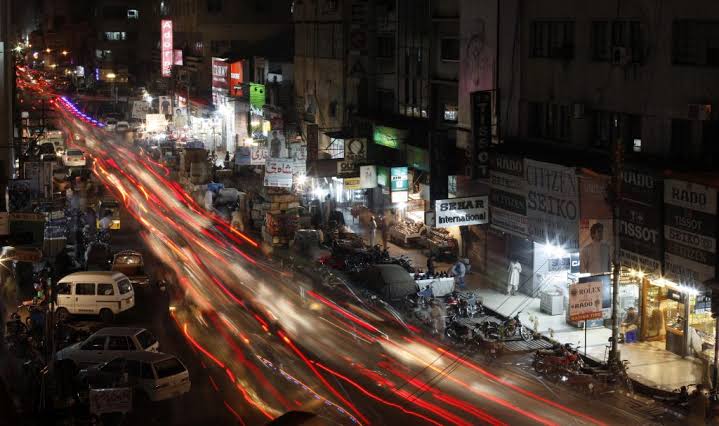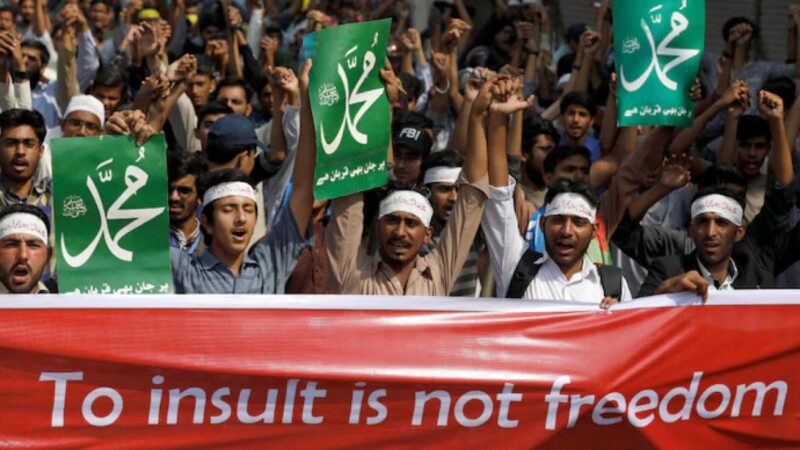After the Iraq War, everyone can visit Saddam’s fabled castles.

The secure, opulent properties owned by the erstwhile strongman were made public following the Iraq War.
Mohammed Hakim ascends the marble stairway, takes a photo as the Euphrates River flows by a genuine sanctuary of palm palms that extends for miles.
He sarcastically referred to former Iraqi leader Saddam Hussein, saying, “He sure knows how to pick a good spot.” One of the mansions that belonged to the overthrown commander is the large structure in which he is standing.
The multistory palace, which overlooks the ancient Babylonian remains, is a physical representation of the powerful kingdom that Saddam envisioned. Spectacular stairs rise up from a grand entryway to enormous chambers that open to a view of the river.
About an hour south of Baghdad, on a man-made hill constructed on the remains of the hamlet of Qawarish, which was destroyed to make room for the strongman’s preferred site, sits the majestic, golden-walled castle.
Current unrest in the “Cradle of Civilization”
Stepping on this territory was unimaginable twenty years ago, before troops from an alliance headed by the United States moved into Baghdad and forced Saddam to leave.
When the alliance attacked the nation on March 20, 2003, the infamous boss was overthrown. After he was overthrown, Iraq briefly harbored lofty hopes that the fall of Saddam might usher in the long-awaited calm and wealth.
Instead, the attack sparked a nearly two-decade-long cycle of conflict and bloodshed that destabilized the entire country and deprived generations of Iraqis of their desire to lead regular lives.
The palace in Babylon, which the general public has now recovered, has provided testimony to the turbulent recent past of a nation generally regarded as the “Cradle of Civilization.”
There are remnants of Saddam here, such as his initials carved on the stone facade and bricks stamped with: “In the reign of the victorious Saddam Hussein, the president of the Republic, may God keep him, the guardian of the great Iraq and the renovator of its renaissance and the builder of its great civilization, the great city of Babylon was rebuilt in 1987.”
Apart from that, the palace is almost completely devoid of any remnants of its former splendor, with its broken windows, graffiti-covered walls, and pigeons breeding in the rafters.
However, Hakim, a 22-year-old college student, is happy to be an Iraqi resident and access the previously prohibited area.
Standing among many others who had come to the location to take in the breathtaking view, Hakim told Al Jazeera, “It’s unreal. “I find it amazing that you don’t need security or bodyguards to accompany you to a location that was once Saddam’s property.”
About the same age as the first young man, he added, “When I enter the palace, I can just imagine that guy [Saddam] sipping his coffee here,” pointing at the entryway to the magnificent palace. He most likely would be pointing his firearms as well.
People were not permitted to make such quips 20 years ago, and they were not in the condition to make gags after the attack either because of the widespread violence and the continuous danger to people’s jobs.
The younger generation in Iraq is once more daydreaming, expecting to create a future that goes beyond the upheaval that molded their childhood, now that the widespread violence has subsided.
Collectively, Iraq’s young are recovering areas that were either previously off-limits under Saddam’s control or too risky during the war.
A portion of Saddam’s old castle in Baghdad’s Adhamiyah neighborhood has been converted into an upmarket retail center where eateries with stunning vistas of the Tigris River welcome Iraqis well into the night.
Around dusk, young people congregate in a plaza by the city’s Jadriyah Bridge to display their motorcycle drifting prowess. Families bring their kids to Abu Nuwas Park for outings because there are amusement amenities there. Along the Tigris, young lovers saunter while rarely holding hands.
We did not lead typical childhoods.
However, generations of Iraqis have only witnessed war and bloodshed taking place in their nation.
Many Iraqis’ memories of their country are defined by the roaring rocket attacks on Baghdad that signaled the start of the invasion, the looting that began almost immediately after Saddam was toppled, the subsequent uprising against the occupation, the sectarian conflict that turned into a full-fledged civil war in 2006, and the ongoing violence that gave rise to the ISIL (ISIS) armed group.
No one should experience even 1% of what we did as children, according to Zainab al-Shamari, a student at the University of Baghdad, who is 21 years old. “We didn’t have a normal childhood,” she said. In 2006, she lost her sibling, and in 2011, she lost her father.
Shia Al-Shamari and her family used to reside in the Dora neighborhood of Baghdad, which was predominantly a Sunni neighborhood. At the height of the communal strife, her brother was murdered in front of their home one day in August 2006, and a letter reading, “Leave this neighborhood or more of you will be killed,” was left by his corpse.
They believed al-Qaeda was responsible for the murder; according to al-Shamari, the military group used Dora as their “playground.” She relocated to Basra, the second-largest metropolis in Iraq, with her family.
Three years after moving back to Baghdad with her family, she spoke to Al Jazeera while strolling down the congested Inner Karada street in Baghdad. Fear of murder, relocation, this fear and that fear, etc.
The tale of Al-Shamari is not unusual in Iraq. Although accurate statistics on civilian deaths over the previous 20 years are difficult to find, the Iraq Body Count initiative estimates that since the 2003 war, about 200,000 citizens have perished. Almost everyone has a tale to share about a loved one or acquaintance who has passed away.
The newer generation’s opinion
As part of the Tishreen movement, tens of thousands of people, mostly youthful Iraqis, went to the streets in October 2019 to call for a reform of the country’s government structure. Members of that movement, however, accuse the nation’s political elites—often supported by powerful militias—of repressing the demonstrations and putting off the calls for change.
Omar al-Hamadi, a 25-year-old engineer who took part in the 2019 demonstrations, told Al Jazeera over the phone: “We were optimistic, but soon we realized that the gangs and political mafias will battle to the end to maintain their interest. In November 2019, he fled Iraq for Istanbul weeks after militants murdered two of his companions when they opened fire on demonstrators.
Al-Hamadi declared, “I will never forgive them, and I don’t think any of my friends will either.”
However, graft and unstable administration in recent years have prevented the country’s young from having a secure future, even for those who were spared the carnage on the streets.
After the 2003 assault, the muhasasa political system—a power-sharing arrangement founded on ethnic and religious division—was created, and it quickly became rife with political intrigue and rampant corruption.
Mustafa al-Kadhimi, a former prime minister of Iraq, claims that over $600 billion has been lost to graft over the previous 20 years. The capacity of the youthful population to build a future in the nation has all but been paralyzed by the widespread misconduct.
According to Hayder al-Shakeri, a research assistant with Chatham House’s Middle East and North Africa program in London, “the political elite have consistently failed to anticipate or address the long-term socioeconomic and environmental challenges likely to be inherited by today’s youth.”
Young Iraqis must pay an extremely high price. Al-Hamadi claimed that “there are no facilities or services in this country because all the money goes to the corrupt officials.”
“Those who can leave—like me—are doing so, and those who can’t leave are still suffering,” the speaker said.
“The country is killing young people every day, even though there are no longer car bombs in Baghdad.”






